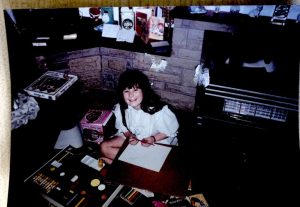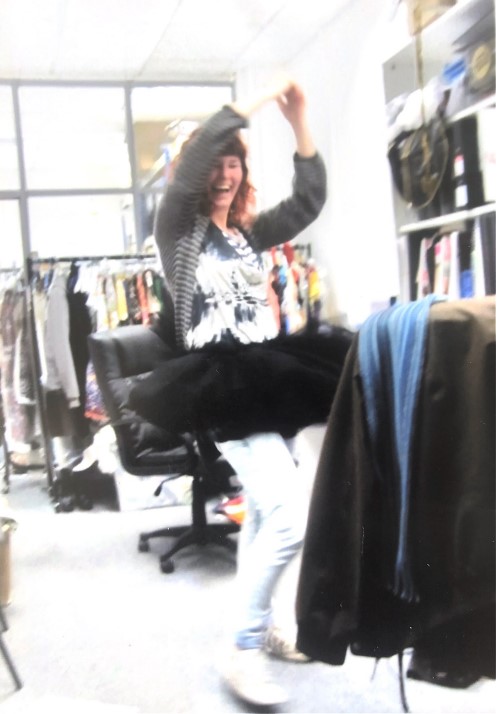We know the path to success doesn’t always go smoothly, so we asked our lecturers about the ups and downs on their path to the University of Brighton. Today we’re speaking to Sarah Humphrey-Smith, fashion design lecturer who says: “I started looking at designers like McQueen and Comme and was just like – I want to do that! I was captivated by the magic of how you could create these spectacles on bodies.”
What were you like at school? Were you a diligent pupil?
“I enjoyed school! I was a top-class student with a mischievous/cheeky side, I guess. Never in too much trouble but if the subject or teacher didn’t maintain my attention it drifted elsewhere.

“I was always more interested in the creative areas such as DT and art, as a result I spent A LOT of time in the art block as it was truly where my focus was. The teachers there were amazing at nurturing my enthusiasm to make. So much so they encouraged me to do and extra GCSE in it in my spare time.”
Why did you decide to go to university?
“In all honesty, after my exams I didn’t. I was so exhausted from studying, being pushed by teachers and striving to be my best self that I wanted a break. So, to my head of 6th form’s dismay, I rejected higher education and got a job in finance of all places!
“After a few years though I felt like I was just a paper-pusher and realised that this really wasn’t making the most of my brain so thought I’d try Uni. I was applying for HR (?!) and on the way to get my reference from the head of 6th form I saw my old Textiles teacher and told her the plan. She instantly said ‘absolutely NOT! You can’t do that! You need to be creative!’ I honestly owe my whole career to that moment. We worked together to sort my dated portfolio out to get to Foundation and the rest is history.”
How did you decide which subject to study?
“Despite that blip in finance, I’d always enjoyed making things from a very young age. I was into anything creative so my career really could have gone many ways. I’d done textiles which was my intro at GCSE and A-level and loved crafting with fabrications and materials, manipulating them and visualising in 3D.
“Being able to play within the subject there such as designing, developing a story, and making really cemented what I wanted to do and where I wanted to be.”
“Then post my stint in finance I had to prep for Foundation and this is where Fashion came in. I started looking at designers like McQueen and Comme and was just like – I want to do that! I was captivated by the magic of how you could create these spectacles on bodies, the materials, the stories, the visions. Foundation allowed me to explore this further whilst dabbling in other creative areas.
“Being able to play within the subject there such as designing, developing a story, and making really cemented what I wanted to do and where I wanted to be.”
What did you do after graduation and why did you choose that path?
“During my studies I’d done two internships with a small high-end fashion house called Aimee McWilliams in London which guided my career decisions. Though I loved all aspects of fashion design, it was at these placements that I realised the full potential of working in 3D as a form of design; so, using pattern cutting or draping as the guiding tool to develop your collection.
“The placement was intense, working long hours but we all worked together side-by-side with the designer to create the collections which was such a buzz. After that I knew, I didn’t just want to sit and draw to design but to be physical and work in 3D so a career as a Pattern Cutter seemed the fit. Pretty much immediately after Uni I moved from Nottingham to London with a focus on this, got an internship with a tiny fashion brand and became their pattern cutter!

“I basically touted myself as freelance and learned on the job. However, as I wanted to work in a ready to wear fashion house I knew I needed to upskill so I did a PGCert in Innovative Pattern Cutting at CSM then worked into the ready to wear scene.”
At what point did you decide that you wanted to teach others?
“One of the joys for me of working at Mary Katrantzou’s for me was working with the interns. Every season we’d have a new batch come through the Atelier who were eager to learn and discover about the brand and fashion and I just loved the sharing of knowledge and skills that happened. I believed that as these students were giving up their time to come and work for us, it was important that they were embedded in the brand, were learning vital skills, were enjoying and excited by experience and were treated equally.
“After I left Mary Katrantzou’s a teaching opportunity came up at London College of Fashion and it seemed like fate; I could work freelance, continue creating and have the opportunity to continue this nurturing of talent”
“This nurturing paid off with several the recruits coming back to work for the brand. After I left Mary’s an opportunity came up for teaching on the MA at London College of Fashion and it seemed like fate; I could work freelance, continue my love for creating and being engaged in the industry as well as have the opportunity to continue this nurturing of talent so I snapped it up. Now it’s this wonderful experience of me sharing my knowledge but me learning from and with the students on new and creative approaches.
Tell us about any career highs… or lows too
“After my PG Cert I began working at Mary Katrantzou who had just graduated, and I think most of my career highs and lows were during this time. I started working there when there was only myself and Mary. Gradually we began building the team and the team we built was fantastic as the creativity, talent, enthusiasm to imagine and produce something new and different was immense.
“We also had tons of fun whilst doing this throughout the company and I think that was the key to the energy and buzz we created. I think the joy of working together to produce these collections was addictive, not just the rush of a show but also when you have break throughs in realising shapes, great fittings, receiving incredible prints and embroideries back or when a seamstress finished a piece for the first time, it worked perfectly, looked incredible and you knew the season was going to be nuts.
“However, as I’ve mentioned this was also some of the lows. It was HARD WORK. It was incredibly long hours and there were many setbacks and times when you thought it wasn’t going to happen. Making a collection in 2 weeks (which happened once) was completely insane and not sustainable.
“I think one of my career lows was being so exhausted I fell asleep behind our archive collection on a role of AstroTurf we were going to use for a show… It’s funny looking back but at the time I felt total despair and anxiety and couldn’t face the pressure anymore.”
“I think one of my lows was being so exhausted I fell asleep behind our archive collection on a role of AstroTurf we were going to use for a show, missing the mayhem of the night before. It’s funny looking back but at the time I felt total despair and anxiety and couldn’t face the pressure anymore. I don’t regret any of my time there, but glad that this pattern of working, which seemed industry wide at the time, as well as the necessity to conform to “seasons” is changing for the better.”
Was there ever a point where you doubted yourself – where you felt that you weren’t going to achieve your goals?
“See above!!
“I doubt myself ALL THE TIME. ‘Have I got this right? Will the designer like it, am I giving the right advice? Do the students understand me? Am I being imaginative enough… it goes on and on. I think as creatives we live in this world of doubt and use it as fire to question and push limits. I guess the key is not to be afraid of it but use it as motivation otherwise its paralysing.”
Read more about Sarah Humphrey-Smith.
Find out about studying Fashion and Textiles degrees at the University of Brighton.

